
 |
  |
The
Patriarchate of Pec:
|
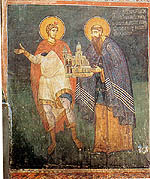 |
|
The
Church of the Virgin, founder's portrait of Archbishop Danilo II
with Prophet Daniel, fourth decade of the 14th century
|
The attractive bipartite window in the Gothic style on the east side of the church was probably built in subsequently, but not long after the construction. In spite of that, this window, like another bipartite Gothic window on the south facade, harmonises well with the architectural whole.
The large sarcophagus made of pale red marble, which contained the relics of the founder, Archbishop Danilo u stands in the north-west corner of the church. A representation of the Preparation of the Throne, symbolising the second coming of Christ and the Last Judgement, is carved under the small blind arcarde in the middle of the front most visible side of the lid of the sarcophagus. Crosses on stepped bases are represented in the other blind arcades on the lid and on the sarcophagus itself.
 |
|
The
Church of the Virgin, window in the apse, mid-14th century (after
A. Deroko)
|
Very little has remained of the old iconostasis - only two small end columns. They show, nevertheless, that the iconostasis was not inferior in beauty to that in the Church of St. Demetrius. The icons in the iconostasis are modern works.
To the left of the iconostasis there is a 19th century wooden chest containing the relics of Archbishop Sava III (1309-1316). To the right of the iconostasis is the Virgin's Throne, with an icon of a more recent date, the prototype of which was made, according to tradition, by St. Luke, the Evangelist. The lavish carving is in the style of the Levant Baroque and is gilded all over. A painting on the throne shows St. Arsenije of Serbia welcoming the icon of the Virgin brought by St. Sava of Serbia from the East. All the paintings on the throne were made by zograph Konstantin and his assistant Ignjat from Veles in 1863, which shows approximately when the throne was carved.
 |
|
The
Church of the Virgin, Descent into the Hades, fourth decade of the
14th century
|
The entire Church of the Virgin is covered with original frescoes, which are in a fairly good state of preservation. The inscription with the precise date of their origin has not been preserved, but there is no doubt that they date from the fourth decade of the 14th century. Most of the work must have been finished by 1337, when Danilo II, the founder of the church, died. His successor, Archbishop Joanikije, seems to have seen to the completion of the remaining paintings, so that some of the frescoes in the lower zones date from the time when he was the head of the Patriarchate of Pec.
The role of Danilo II as the founder of the church is also attested by the valuable composition on the west wall of the church. Archbishop Danilo II, with a tonsure and dressed in modest clothes, holds a model of the Church of the Virgin, as well as of the narthex, which he constructed at the same time. By a gesture of his hand he addresses Old Testament prophet Daniel, after whom he got his monastic name, and who also holds the model of a church. The prophet recommends Archbishop Daniel to the Virgin, tinted in an opening in the wall. The figure of Daniel II is especially remarkable element m this simple and retrained composition: the learned leader of the Serbian Church radiates wisdom and nobility of mind, and the founder's model in his hand is of great documentary value.
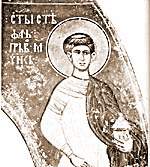 |
|
The
Church of the Virgin, St. Stephen, the First Martyr, fourth decade
of the 14th century
|
There is another representation of Danilo II, but it is inferior in artistic worth. In this case the founder is shown in formal archiepiscopal robes, but one would hardly guess by the expression of his face that he was one of the greatest Serbian medieval writers. This fresco shows Danilo with St Nicholas, and it originally stood above the founder's grave, on the west wall, but it was transferred from there to the south-west pilaster in 1967, in order that the earlier figure of a saint might be uncovered. Danilo II is represented as a saint, so it is thought that this portrait was made after his death, at the time of Archbishop Joanikije. This view is supported by the fact that the portrait was painted over an earlier fresco.
The other figures in the lowest zone include groups of warrior saints, saintly healers and monks. Significantly, St. Sava of Serbia is included among the distinguished holy fathers in the Adoration of the Lamb represented in the sanctuary.
The painters placed the cycle dedicated to the Virgin in the middle zone of the church, on the south wall of the sanctuary and in the space beneath the dome. This is what one could expect in a church dedicated to the Virgin. The Posthumous Appearances of Christ are painted in the middle zone of the opposite, north wall. The highest zone and the vaults contain the usual representations of The Twelve Great Feasts. Especially remarkable is a scene of the Descent into Limbo after Resurrection, shown with a wealth of details, which replaces the Resurrection in Eastern Christendom.
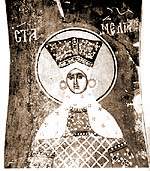 |
|
The
Church of the Virgin, St. Kyriaka, fourth decade of the 14th century
|
In the highest part of the dome is the figure of Christ Pantokrator. The Divine Liturgy, which Christ holds with angels, the zone with the prophets between the windows and the representations of the Evangelists on the pendentives correspond to the usual iconographic pattern of the first half of the 14th century. The only unusual feature is the fact that the Evangelists are represented with their Christian muses - the personifications of Wisdom - in the form of beautiful angels.
The small groups placed in the corner areas of the church are the most interesting as regards their subject matter although their artistic worth is not very great. The life of Archbishop Arsenije, the successor of St. Sava of Serbia on the patriarchal throne of Pec, is painted very summarily in four compositions, on the not clearly visible vault surfaces in the prothesis, north of the central part of the sanctuary. The choice of this subject shows the wish of the Serbian Church to enhance the reputation of and pay respect to its eminent representatives, as well as to glorify its first founder. The popular cycle of St. John the Baptist, one of the most eminent of Old Testament figures, is shown in the diaconicon, opposite the prothesis. The important events connected with his name from his birth to the finding of the saint's head are represented succinctly, in five compositions.
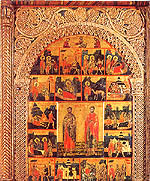 |
|
The
Church of the Virgin, icon of saint healers Cosmas and Damian, with
scenes from their lives, 1674
|
The frescoes in the north-west area of the church form a distinct group. The lowest zone contains several figures, mostly saints healers, and the upper zones are devoted to the Virgin, the patroness of the church. Two scenes - Moses in front of the Burning Bush and Tabernacle of Witness - are painted on the vault, where they are not very clearly visible. Although they illustrate two events from the turbulent history of the Jewish people, they are shown here because of their symbolical implications, for they were interpreted as symbols of the Virgin, or rather of her purity and virginity. Below these two compositions there is a scene showing the Virgin feeding the poor through the mediation of the Christ child; in the figurative sense, she strengthens them with spiritual gifts.
These learned theological paintings are stylistically considerably heterogeneous. Several individual styles are displayed by the masters who had a substantial share in the painting of the Church of the Virgin. Some of them still hold on to the early 14th century ideas, while the others strive, with varied success, to strike along new paths.
The painter of a portion of the Great Feasts, especially the Crucifixion, The Three Marys and the Descent into Limbo, was obviously trained in a studio associated with the masters whom King Milutin had gathered at his court. The well-proportioned figures in his compositions are painted with great care, especially the uncovered parts of their bodies besides the anonymous artist skilfully evokes a Dramatic atmosphere. Neo-classical features of style are alien to the master who painted the scenes of the Ascension, Christ Appearing to the Apostles behind the Locked Door, The Doubting of Thomas. His figures with small heads display restlessness in movement and gesture, volume is not very carefully represented, and decorative elements are Besides these two masters there were others, whose knowledge and skill were inferior to theirs. Fortunately, their work is not so conspicuous, because their paintings are in less accessible areas (the cycle of St. Arsenije of Serbia, saint healers in the north-west corner of the church, etc.).
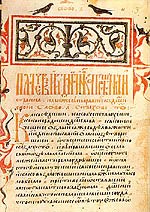 |
|
The
Church of the Virgin, manuscript of the Dioptra, page with head-piece,
early 15th century
|
The fact that the share of individual masters can be distinguished does not mean that the frescoes in the Church of the Virgin do not have certain common features. With a few exceptions, the painters were not skilful draughtsmen and their sense of colour was not very refined. In spite of these deficiencies, it should not be concluded that Archbishop Danilo II engaged artists who were not up to their task - in the final analysis, they were competent masters of their time.
History
/ People / Spirituality
/ Churches / Arts
/ Links
Main page / Serbian